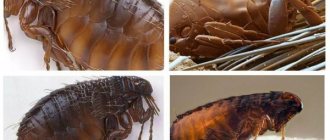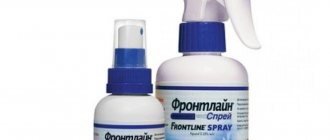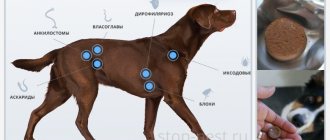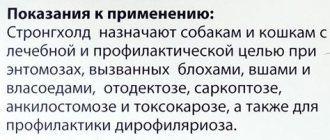Blood-sucking ectoparasites not only cause itchy skin that bothers pets, but also carry serious diseases. Both free-roaming pets and those that have never been outside can become infected with them. A lot of products have been developed to combat fleas, among which the imported Front Line line stands out.
Let's learn how to use different forms of this drug for cats.
Skin parasites of cats
The most common and common in cats are:
- Fleas choose not only animals as victims, but also humans. Insects actively jump on the animal's skin and are easy to notice. More than 60 species of blood-sucking parasites carry over 200 diseases: anthrax, typhoid fever, salmonellosis, helminthiasis, and various fungal infections. Adult fleas do not live on the victim's body 24 hours a day. Having had enough, they leave the cat.
- Lice eaters are small wingless insects. They feed on particles of fur and epidermis, and blood. Like other ectoparasites, lice eaters force the cat to constantly scratch the skin until wounds appear. Damaged skin is easily attacked by pathogenic bacteria. When a cat is infected with a lice-eater, sleep and appetite are disrupted, immunity decreases, and allergies occur.
- Lice - when infested with lice, the animal behaves restlessly, scratches the skin, and loses hair. Lice are easy to spot. On your pet's light coat, black dots that look like dirt and dust are clearly visible - these are parasite excrement. In case of mass infection, the animal faces dermatitis and complete baldness. Lice are carried by helminth larvae.
- Ixodid ticks - attack cats in the warm season. These small insects feed on blood and grow greatly in size. A swollen tick can be noticed immediately. A cat's skin and fur are very sensitive, so the animal can easily shake off an unattached tick from its skin. In search of food, insects willingly move onto people. Ticks carry many diseases: viral encephalitis, typhus, tularemia, hemorrhagic fever, piroplasmosis, helminthiasis, etc.
- Scabies mites live on the skin of a cat, gnawing passages in the inner layer of the dermis. They feed on epithelial cells and lymph. From a sick animal the tick is transmitted to people.
- Sarcoptoid mites are the cause of scabies. The peculiarity of this form is the rapid baldness of the ears, belly and muzzle.
- Ear mites - attack the animal's hearing system. The cat shakes its head and tries to get its hind paw inside the ear. Dark brown crusts form in the ears, followed by pus. Without treatment, the parasites gradually penetrate through the inner ear into the brain, and the animal dies.
- Heartworms (dirofilaria) cause one of the most dangerous diseases, dirofilariasis. The helminth larvae enter the mouthparts of the mosquito with the blood of the infected creature, and with the next bite the parasites enter the body of the final victim. They live under the skin, in the muscles of internal organs. Parasites destroy the heart, lungs, and coronary vessels. Without treatment, the animal faces death.
Photo gallery: dangerous cat ectoparasites
Fleas are the most common skin parasites
Hairworm - the cause of focal baldness in cats
Cat lice are as common as fleas, although they are less well known.
Hungry and well-fed ticks are very different in appearance
Getting rid of ear mites is a long and expensive task.
Heartworm is the causative agent of dirofilariasis, spread by mosquitoes.
How to use Frontline medications?
It is necessary to use drugs carefully, because if a cat licks the area where the drug was applied, this can result in poisoning and gastric lavage.
If your kitten itches frequently, you should treat it immediately.
The instructions for use prescribe the following rules of use:
- One pipette – one-time treatment.
- To treat ear mites, Frontline drops for cats must be applied directly into the auricle. 4-6 drops are dripped into each ear, after which the auricle is folded in half and massaged a little at the base. This is done so that the product is better distributed.
- Frontline drops for cats must be applied strictly to a specific area - to the area between the shoulder blades. This is where the animal cannot reach when licking. By spreading the fur, you need to squeeze out the product.
- When treating an animal with Frontline spray, you must first calculate the number of presses depending on the body weight and volume of the product bottle.
- Swimming is not recommended in the first two days, as this may reduce effectiveness.
- If there are several cats in the house, treatment should be done not selectively, but to all cats at once.
- For very young kittens, a spray is used, and from 2 months you can take drops.
Consumer reviews indicate that on average 3 weeks are enough to completely eliminate the parasite problem.
In some cases, when there is a fight against adults and pre-imaginal phases of insect development, a double period may be required (i.e. approximately 6 weeks).
Swim only two days after treatment!
Some owners become nervous if more than a day has passed since the treatment, but insects on the animal’s body are visible to the naked eye.
If a cat's fleas have not disappeared from Frontline within 21 days, this means that a re-infection has occurred.
This could happen from other animals in the house or on the street, as well as due to the presence of insect eggs and pupae in bedding, carpets, and upholstered furniture.
The maximum time during which the manufacturer guarantees complete elimination of parasites is three months.
Composition and release form of the drug Frontline
To combat skin parasites of cats, the French corporation Merial SAS created the drug Frontline. The company conducts serious research and has a strong reputation in the market for manufacturers of veterinary drugs.
The drug is available in three dosage forms:
- drops in polyethylene pipette bottles with a volume of 0.5 to 4.02 ml;
- spray in bottles with a sprayer of 100, 250 and 500 ml;
- Chewable tablets (for dogs only)
Table: dosage forms for cats
| Name | Dosage form | Volume, ml | Included | |
| active substance | Excipients | |||
| Frontline Spot On | drops on the withers |
| fipronil |
|
| Frontline Combo | drops on the withers |
|
|
|
| Frontline Spray | spray |
| fipronil |
|
Photo gallery: release forms
Frontline spray with a volume of 100 and 250 ml is most convenient for home use
Drops for the withers Frontline Spot It are available in a dropper bottle with detailed instructions
Frontline combo acts not only on adult parasites, but also on their eggs and larvae
Frontline Nexgard meat-flavored chewable tablets are for use only in dogs.
Active ingredients of the veterinary drug Frontline:
- Fipronil has a detrimental effect on the central nervous system of parasites, disrupting the movement of nerve impulses. Causes paralysis and subsequent death of insects. Fipronil does not have a systemic effect on the body of a pet, destroying only pests.
- S-methoprene (as part of Frontline Combo) is an analogue of the hormone-regulator of insect growth, causes developmental anomalies at the egg and larval stages, prevents the appearance of adult individuals on animals and in places where they are kept.
Additionally, Frontline contains excipients:
- in the spray - isopropanol, copolyvidone, purified water, polysorbate;
- in drops on the withers - butylated hydroxyanisole, butylhydrotoluene, diethylene glycol, polyvidone, polysorbate.
The content of the active substance in any form ensures effective destruction of parasites.
How to distinguish from a fake
Since the drug Frontline is a popular remedy and is often recommended by veterinarians, fakes are sometimes found in pet pharmacies. To protect yourself from a useless purchase, it is worth knowing the distinctive features of the original. These include:
- A plastic container with drops is always packed in a sealed cardboard package;
- The Frontline logo is printed directly onto the dropper itself;
- The company name is printed on the packaging;
- The batch number and production date are duplicated on the applicator and cardboard base;
- Each copy is accompanied by a leaflet with detailed instructions for use;
- There are no additional holograms or stickers on the packaging;
- For Frontline spray and drops, the composition, concentration, and volume of the drug are indicated;
These external signs are classic. Merial periodically changes some design elements. The color of the packaging or the photo of the cat may change. Some blisters are marked “PCT”, which replaces the Soviet quality mark and means that the product meets the requirements of GOST certification.
Mechanism of action
After use, the active substance does not penetrate into the blood, but is distributed throughout the skin and hair. The drug has a contact effect - parasites die when they come into contact with Frontline microparticles. After the product gets on the skin, the active agents fipronil and S-methoprene, together with sebum, are distributed over the surface, enveloping the hairs and covering every millimeter of the cat’s body with an invisible veil.
Frontline acts contactally, destroying only parasites
Advantages
The benefits of the product include:
- Convenient packaging. Thanks to the pipette, it is easy to apply; the liquid does not get on human skin and does not leave marks on it. This type of packaging helps to accurately calculate the dosage of the medicine.
- Efficiency. The drug destroys all types of insects, even those that have managed to lay larvae on the skin of a pet.
- There are no age restrictions. The Frontline line of antiparasitic drugs includes 3 types of medicinal products with different compositions and specific purposes. Frontline spray can be used by kittens from two days of age.
- Fast action. The medicine kills parasites within 24 hours.
The main advantage of the drug is the prevention of repeated episodes of insects.
How to use Frontline correctly - treatment algorithm
Before treatment, it is recommended to weigh the cat, determine the required dose, comb the cat’s fur, and remove all tangles. The pet's skin must be completely dry, undamaged, without open wounds or visible scratches at the site of application. For cats, the drug Frontline is used in 0.5 ml applicators.
The procedure for treating a cat with drops on the withers at home:
- Wear protective gloves.
- Remove the dropper bottle from the packaging, move the drug into the wide part of the bottle using tapping movements, and unscrew the tip of the dropper.
- Spread the fur at the withers, exposing the skin at the junction of the cervical spine and the thoracic spine (on the shoulder blades).
- Squeeze the pipette and apply a few drops of the solution in a heap, in a checkerboard pattern.
- Distribute the preparation over the skin, running your hand several times against and along the growth of the fur.
Video: how to treat a cat for fleas using drops
Remember! Drops are applied pointwise in a checkerboard pattern to the area between the shoulder blades (at the withers).
To get rid of ear mites, 4-6 drops are injected into each ear canal. To distribute the drug evenly, the ear is closed and easily kneaded. The remaining drops in the pipette bottle can be applied to the withers.
Remember! For 2 days after treatment, protect the cat’s fur from moisture, do not bathe or use other drugs against skin parasites.
The procedure for self-treating a cat with Frontline spray:
- Processing should be done outdoors or in a well-ventilated area.
- Wear protective gloves and respiratory protection.
- Fasten the pet's protective neck collar and secure its jaws until the preparation dries completely on the fur.
- Fluff the cat's fur against the natural hair growth.
- Shake the bottle thoroughly.
- Holding the spray can upward at a distance of 10–20 cm from the cat, press the head of the aerosol can.
- Treat your pet until the fur is moistened, starting from the tail: back, belly, limbs.
- To treat the face, groin and armpits, apply the product to the glove and rub into the fur, avoiding contact with the eyes and mucous membranes.
- Brush the fur with a wide-toothed brush to get the product onto the skin.
The drug consumption is 3 ml per 1 kg of weight for short-haired cats and 6 ml for long-haired cats. The product is convenient to dose: one press removes a 0.5 ml dose of Frontline from a 100 ml bottle.
Typically required for cats weighing:
- up to 5 kg - from 30 for short-haired to 60 clicks for long-haired animals;
- up to 10 kg - from 60 to 120 presses;
- up to 15 kg - from 90 to 180 presses.
A single treatment of a cat with Frontline kills parasites in 1–2 days. Barrier protection against ticks lasts for 4 weeks, against fleas, lice and lice for 6 weeks.
Video: how to treat your pet for skin parasites using a spray
Remember! Treat all animals in the house, change bedding or disinfect them, otherwise re-infection is possible.
I recently got a new cat. A foundling, like all my animals. The poor guy jumped out onto the road opposite the dacha cooperative. It was at the end of autumn, with the onset of the first cold weather. The unfortunate animal was on the verge of death. I took him home. The cat was so scared and exhausted that I decided to give him time to recover from the stress. He went to the vet 3 days later. Upon examination, all possible parasites were discovered: worms, fleas and ear mites. The cat was prescribed treatment. The doctor advised to wait 5 days and treat for fleas and helminths. While the waiting period was passing, the other cat also began to itch, although the animals had almost no contact. During the second visit, the veterinarian recommended treating the cat with Frontline Combo anti-flea drops on the withers once, and treating the cat with Frontline Spot On drops twice according to the scheme. And he focused on replacing or disinfecting bed mats. I didn’t even think about changing the bedding! There was no need to wear any collars, and there was no aggressive smell; both pets tolerated the procedure well. An easy and simple solution, and the fleas were defeated. I noted for myself the importance of regular flea treatment. Parasite eggs can be brought in from the street on the soles of shoes. And then the infection will occur again.
Frontline spray
The aerosol product is produced in bottles of 100; 250 ml.
The cost of a 100 ml bottle in September 2022 is 845 rubles.
The spray protects cats from ixodid ticks for 3 weeks, fleas - 6 weeks. The dogs will be free of ectoparasites for 5 and 12 weeks respectively. Dispense the drug with the number of presses on the spray head in accordance with the table:
| Live weight, kg | Number of clicks | |
| 100 ml | 250 ml | |
| 5 | 30 | 10 |
| 10 | 60 | 20 |
| 15 | 90 | 30 |
| 25 | 150 | 50 |
The table provides recommendations for treating pets with short hair. For long-haired dogs, the number of presses is doubled. To prevent a cat or dog from licking the insecticide, place a neck collar, muzzle, or tie the closed jaws with a rope while it dries. Avoid contact of the aerosol with the eyes. Problem areas are treated with your finger after wearing gloves.
The animal should not be allowed to get wet for two days after treatment. There are no restrictions on the weight and age of the animal. The aerosol is stored for 2 years at temperatures from 0 to 25 °C.
Indications for use
Frontline is prescribed to cats:
- for the treatment and prevention of diseases caused by fleas, lice and lice, ixodid ticks;
- complex therapy of allergic dermatitis caused by fleas;
- to prevent the attachment and development of ectoparasites on animals.
Frontline Spot It repels mosquitoes and destroys:
- mature fleas;
- lice eaters;
- ixodid ticks (all phases of development);
- lice;
- scabies mites.
Frontline Combo also repels mosquitoes and destroys:
- fleas (mature and insects in the egg, larvae, and pupal stages);
- lice eaters;
- ixodid ticks (all phases of development);
- sarcoptoid mites.
Frontline Spray is used to destroy:
- mature fleas;
- lice eaters;
- ixodid ticks (all phases of development);
- lice.
Use of the product for kittens and pregnant cats
The drug does not have a toxic effect on the fetus and the growth of cubs, therefore it is successfully used in the treatment of kittens, pregnant and lactating cats.
Frontline protects both small kittens and nursing cats equally effectively
When treating a lactating cat, Frontline Spot On drops are better suited. Then there is no need to isolate the cubs or wait for the moisture to evaporate from the mother’s hair. Kittens over two days old can be treated with a spray. However, for such babies, the manual method of extermination will be simple and safe. In the delicate fur, tiny pests can be easily caught.
Analogues of the drug
When choosing analogues of Frontaline, it is necessary to note the effectiveness, as well as the smallest number of side effects that occur when treating cats.
Potential analogues of Frontline are the following insectoacaricides:
- Advantix drops (Bayer, Germany);
- Bolfo spray (Bayer, Germany);
- Ultra Guard drops (Hartz, USA).
Before starting to use any type of antiparasitic medication, you should always consult with a veterinarian.
Contraindications and side effects from the drug Frontline
The product is not used:
- with hypersensitivity to the components of the drug;
- for infectious diseases;
- with decreased immunity after a recent illness;
- in the process of treating otodectosis (ear mites) when the integrity of the eardrum is damaged;
- in case of possible contact of the drug with the mucous membrane of the eyes, on wet or damaged skin.
When used according to the treatment regimen, the drug does not have any side effects. If the dose of a veterinary drug is exceeded, the animal may experience:
- salivation;
- vomit;
- rapid breathing.
If symptoms of overdose are pronounced, the cat should be shown to a veterinarian, the animal should be washed with hypoallergenic pet shampoo, and antihistamine therapy should be administered.
Remember! Strictly adhere to the regimen of using the drug, otherwise the effectiveness of killing parasites will decrease.
Contraindications
Frontline is not prescribed to furry patients with infectious diseases, weakened pets, kittens and puppies under eight weeks of age. Baby ferrets can only undergo the procedure from 6 months after birth. Frontline cannot be used for dogs weighing less than 2 kg and cats weighing up to one kilogram.
The medication should not be combined with other medications intended to combat parasites in order to avoid intoxication. The medicine is not intended for use in farmed animals producing food for humans.
Approximate cost and existing analogues
In online stores the drug can be purchased at a price of 880 rubles. for a 100 ml spray bottle, Frontline Spot On drops - 460 rubles, Frontline Combo drops - 520 rubles. per dropper bottle.
Table: analogues of the drug Frontline
| Drug name | Release form | Country of Origin | What parasites does it protect against? | Active substance | Price, rub | Compared to the drug Frontline Spot On drops on the withers | |
| dignity | flaws | ||||||
| Stronghold | drops | USA |
| selamectin | 800 |
|
|
| Blokhnet |
| Russia |
| fipronil | 100 | significantly lower price | minimum drop volume 1 ml. |
| Fiprist |
| Slovenia |
| fipronil | 300 |
| shorter duration of action. |
| Leopard |
| Russia |
| fipronil | 70 |
| Contraindicated for pregnant and lactating cats. |
| Rolf | drops | Russia |
| fipronil; pyriproxyfen. | 200 | lower price |
|
| Advantage | drops | Germany |
| imidacloprid | 250 |
| less protection (not effective against ticks). |
Frontline - what is it?
One common product that provides such protection against fleas and other pests is Frontline spray and drops.
This series includes drugs to protect cats, dogs and even ferrets .
The safe area for treatment is between the two blades
Important! In more than half of the cases, owners do not notice that the pet is infected. That is why the issue of permanent protection is so relevant.
The drug has an insectoacaricidal effect.
The main component of Frontline drops for cats affects the central nervous system of insects: it blocks excitatory receptors and the possibility of transmitting nerve impulses.
As a result, the parasites become paralyzed.
When there are several furbabies at home, it is not known which of them caught the parasites first. Everyone needs to be treated without exception.
The main advantages of Frontline products for cats and fleas are the following:
- within one day, all pests that are on the pet’s body will be eliminated;
- when using the product only once, the pet will be protected for a long period of time;
- no matter what breed of cat you have, Frontline against fleas and ticks is absolutely safe;
- affordable price for Frontline for cats.
How often can drops and spray be used?
Frontline drops for cats should be used monthly. Only in this way can the active ingredient fipronil disrupt the life cycle of fleas and kill all ticks. The effect of the product can be observed for six weeks, but the risk of re-infection and the development of flea dermatitis appears after 4 weeks. You also need to remember that the effect of the Spot He solution stops after swimming, immersion in water, or after aggressive exposure to sunlight. But Spray and Combo are not afraid of weather surprises.
Some owners refuse to treat their animals monthly, citing the fact that fleas and ticks develop immunity to the drug. There is no scientific evidence for this claim. Difficulties in controlling fleas may be due to changing weather conditions or poor home hygiene. Effective control of parasites includes not only continuous year-round treatment of the animal, but also regular washing of bedding and mopping of floors.











